Films
The Disarming Case To Act Right Now On Climate Change
We’ve had 30 years of pep talking and selling positive ideas, and I’m sorry, but it doesn’t work because if it would have, the emissions would have gone down by now. They haven’t.
Greta Thunberg says it like it is. She’s a high school student from Sweden, speaking truth to global power. If you haven’t heard, she’s been skipping school to protest for action on climate.
“Some people say that I should be in school instead. Some people say that I should study to become a climate scientist so that I can solve the climate crisis. But the climate crisis has already been solved. We already have all the facts and solutions. All we have to do is to wake up and change. Why should I be studying for a future that soon will be no more, when no one is doing anything whatsoever to save that future? And what is the point of learning facts in this school system when the most important facts given by the finest science of that same school system clearly means nothing to our politicians and our society.”
Vandana Shiva on Sustainability
“Whatever I do, I do from a deep love… a very deep love for life and all its gifts and bounties. And it’s that love that replenishes me and recharges me to go on. I’m not doing a job for anybody. Nobody is paying me a salary—this much nine-to-five and a little bonus if you do more. No, this is about living. It is about the joy of living. And if that joy of living requires that those who are robbing the planet of its life, those who are robbing people of their lives have to be resisted and questioned, I will do that too. That too is part of my resistance.”
Let’s Not Use Mars As A Backup Planet
Among young people, ideas like colonizing Mars are enticing. Lucinanne Walkowicz urges us to reconsider notions that we could escape environmental crisis on Earth. Even the most inhospitable deserts and ice caps on Earth are still more habitable than Mars.
This Country Isn’t Just Carbon Neutral—It’s Carbon Negative
As one of the happiest nations on Earth, Bhutan is leading the way in alternative thinking about our shared destiny as humans. What would it look like to have a country that prioritized happiness above all else and considered deeply future generations? Tshering Tobgay shares some of his vision.
A Fierce Green Fire
This documentary guides viewers through the history of environmentalism through an empowering lens of collaboration, cooperation, and success in unlikely fights. Taking a look at the environmental movement’s connection to matters of water pollution, toxic waste, climate change, whaling, and damming—just to name a few—A Fierce Green Fire reminds us of the passion that comprises the foundation of the environmental movement.
How to Let Go of the World and Love All the Things Climate Can’t Change
How to Let Go is a feature-length film that follows director Josh Fox to multiple countries on six out of the seven continents as he investigates the ramifications of climate change—putting a spotlight on rising oceans and superstorms, amongst other environmental phenomena that are becoming increasingly common in recent history. Fox acknowledges the irreparable effects of climate change, introduces us to passionate activists across the globe, and ultimately asks the viewer: “what are the things that climate change can’t destroy? What are those parts of us that are so deep that no storm can take away?” How to Let Go is characterized by Fox’s human-centered approach to what may often be delivered as a strictly scientific issue, providing the viewer with some semblance of hope and foresight in an progressively unpredictable and challenging era.
Articles
How Long Before These Salmon Are Gone? ‘Maybe 20 Years’
Some 45,000 to 50,000 spring-summer Chinook spawned here in the 1950s. These days, the average is about 1,500 fish, and declining. And not just here: Native fish are in free-fall throughout the Columbia River basin, a situation so dire that many groups are urging the removal of four large dams to keep the fish from being lost.
Read the full article
The Crisis for Birds Is a Crisis for Us All
Nearly one-third of the wild birds in the United States and Canada have vanished since 1970, a staggering loss that suggests the very fabric of North America’s ecosystem is unraveling.
The disappearance of 2.9 billion birds over the past nearly 50 years was reported today in the journal Science, a result of a comprehensive study by a team of scientists from seven research institutions in the United States and Canada.
Read the full article
Greta Thunberg’s Climate Panic Has Our Attention. Now What?
As a member of an older generation, I am thankful for this new youthful energy. But at the risk of coming across as a lecturing parent, I also have some advice: Zweckpessimismus only goes so far. We need optimism too. Otherwise, your steady calls of alarm risk becoming a complacent routine in itself.
Read the full article
Beyond Renewables: How to Reduce Energy-Related Emissions by Measuring What Matters
Despite the uptick in renewable energy usage, global emissions have steadily increased.
Read the full article
Companies See Climate Change Hitting Their Bottom Lines in the Next 5 Years
“After analyzing submissions from 215 of the world’s 500 biggest corporations, CDP found that these companies potentially faced roughly $1 trillion in costs related to climate change in the decades ahead unless they took proactive steps to prepare. By the companies’ own estimates, a majority of those financial risks could start to materialize in the next five years or so.
The disclosures show how business leaders expect climate change, and the policy responses to it, to ripple through every corner of the global economy.
Many firms are bracing for direct impacts. Hitachi Ltd., a Japanese manufacturer, said that increased rainfall and flooding in Southeast Asia had the potential to knock out suppliers and that it was taking defensive measures as a result. Banco Santander Brasil, a large Brazilian bank, said increasingly severe droughts in the region might hurt the ability of borrowers to repay loans. Google’s parent company, Alphabet, Inc., noted that rising temperatures could increase the cost of cooling its energy-hungry data centers.”
Read the full article
Soil as Carbon Storehouse: New Weapon in Climate Fight?
The damage or disappearance of ecologies and plant cover have caused significant soil degradation, which, it turns out, has released much CO2 into the atmosphere. In fact, the world’s cultivated soils have lost between 50 and 70 percent of their original carbon stock, according to recent research, much of which has oxidized upon exposure to air to become CO2. But new research is finding ways to recapture CO2 through land restoration.
“Recognition of the vital role played by soil carbon could mark an important if subtle shift in the discussion about global warming, which has been heavily focused on curbing emissions of fossil fuels. But a look at soil brings a sharper focus on potential carbon sinks. Reducing emissions is crucial, but soil carbon sequestration needs to be part of the picture as well, says Lal. The top priorities, he says, are restoring degraded and eroded lands, as well as avoiding deforestation and the farming of peatlands, which are a major reservoir of carbon and are easily decomposed upon drainage and cultivation.
Goreau says we need to seek opportunities to increase soil carbon in all ecosystems — from tropical forests to pasture to wetlands — by replanting degraded areas, increased mulching of biomass instead of burning, large-scale use of biochar, improved pasture management, effective erosion control, and restoration of mangroves, salt marshes, and sea grasses.
Scientists say that more carbon resides in soil than in the atmosphere and all plant life combined; there are 2,500 billion tons of carbon in soil, compared with 800 billion tons in the atmosphere and 560 billion tons in plant and animal life. And compared to many proposed geoengineering fixes, storing carbon in soil is simple: It’s a matter of returning carbon where it belongs.”
Read the full article
How Big Business Is Hedging Against the Apocalypse
Investors are finally paying attention to climate change — though not in the way you might hope.
Global energy consumption is rocketing upward every year: The Energy Information Administration expects it to climb another 28 percent within a generation. Hydropower, wind and solar contribute about 22 percent of the total, and their share grows yearly. But the net amount of energy generated by hydrocarbons is growing yearly, too.
Unlike almost every other future event, climate change is 100 percent certain to happen. What we don’t know is everything else: where, or how, or when, or what the changes mean for Facebook or Pfizer or notes of Chinese-government debt. Navigating these thickets of complexity is theoretically what Wall Street excels at; the industry prides itself on its ability to price risk for the whole economy, to determine companies’ values based on their likelihood of generating earnings. But traders are compensated on their quarterly or yearly performance, not on their distant foresight.
What is odd about many of these climate plays, which rely on such complex assumptions about the future, is how myopic they seem. They assume that the world will change around a stable, fixed point. American weather will curdle to such a degree that Tennessee will become an incubator for malaria, yet Wall Street banks and patent lawyers will saunter along as usual. Rising oceans will submerge coastal financial centers beneath several feet of saltwater, yet commodities markets will pay top dollar for Greenlandic uranium. Taken individually, these assumptions sound dubious. But as a whole, they mirror what’s happening on Wall Street. Each successive year incinerates the temperature figures of the previous one, yet the stock market continues to break records.
Read the full article
Climate Change Could Destroy His Home in Peru. So He Sued an Energy Company in Germany.
Increasing glacial melt is creating unstable, increasingly problematic glacial lakes, especially in the Andes and Himalaya Mountains. In Peru, Guardians are charged with watching these lakes to try to prevent a catastrophic flood.
Using similar methods that eventually were successful in bring lawsuits against Big Tobacco, vulnerable populations are trying to sue the large corporations that have overwhelming contributed to climate change. Surprisingly, just 90 companies are responsible for two-thirds of all the greenhouse gases emitted between 1751 and 2016. More than half those emissions have occurred since 1988. Still, it is an incredibly complex question to figure out the harm and recompense involved in large-scale, complex systems like earth’s climate.
Since 2017, eight United States cities, including New York and San Francisco, six counties, one state and the West Coast’s largest association of fishermen have brought suit against a host of corporations — Exxon Mobil, Royal Dutch Shell, BP, Chevron, Peabody Energy, among others — for selling products that caused the world to warm while misleading the public about the damage they knew would result.
Read the full article
Environmentalism as Religion
In this article, Joel Garreau explores the idea that environmentalism has become the new religion of choice for urban atheists, overtaking the traditional place of socialism for them.
In a widely quoted 2003 speech, Crichton outlined the ways that environmentalism “remaps” Judeo-Christian beliefs:
“There’s an initial Eden, a paradise, a state of grace and unity with nature, there’s a fall from grace into a state of pollution as a result of eating from the tree of knowledge, and as a result of our actions there is a judgment day coming for us all. We are all energy sinners, doomed to die, unless we seek salvation, which is now called sustainability. Sustainability is salvation in the church of the environment. Just as organic food is its communion, that pesticide-free wafer that the right people with the right beliefs, imbibe.”
According to Garreau, environmentalism has: 1) merged with Eastern-based spiritualism and concepts lifted from Hinduism, Daoism, or Buddhism; 2) harked back to pagan and animist traditional (pre-scientific) beliefs; and 3) and started a “greening” process of Judeo-Christian theology.
Freeman Dyson, the brilliant and contrarian octogenarian physicist, agrees. In a 2008 essay in the New York Review of Books, he described environmentalism as “a worldwide secular religion” that has “replaced socialism as the leading secular religion.” This religion holds “that we are stewards of the earth, that despoiling the planet with waste products of our luxurious living is a sin, and that the path of righteousness is to live as frugally as possible.” The ethics of this new religion, he continued,
“are being taught to children in kindergartens, schools, and colleges all over the world…. And the ethics of environmentalism are fundamentally sound. Scientists and economists can agree with Buddhist monks and Christian activists that ruthless destruction of natural habitats is evil and careful preservation of birds and butterflies is good. The worldwide community of environmentalists — most of whom are not scientists — holds the moral high ground, and is guiding human societies toward a hopeful future. Environmentalism, as a religion of hope and respect for nature, is here to stay. This is a religion that we can all share, whether or not we believe that global warming is harmful.”
Both Dyson and Garreau make a case that there is nothing wrong with the modern ecology movement and environmentalism being partially based on faith and belief and, like religion, looking partially beyond science and empiricism. But both of them warn that environmentalism could become a guilt-based Carbon Calvinism or turn to irrationalism. As Branden Allenby has written about the language of the carbon fundamentalists:
“indicates a shift from [seeking to help] the public and policymakers understand a complex issue, to demonizing disagreement. The data-driven and exploratory processes of science are choked off by inculcation of belief systems that rely on archetypal and emotive strength…. The authority of science is relied on not for factual enlightenment but as ideological foundation for authoritarian policy.”
Read the full article
The Tiny Swiss Company That Thinks It Can Help Stop Climate Change
Can two scientists from a Swiss firm called Climeworks perfect a novel process of “direct air capture” to remove CO2 from the atmosphere, bottle it, and store or sell it? Although Climeworks’s existing rooftop plant currently requires significant energy inputs to function, the two entrepreneurs (Christoph Gebald and Jan Wurzbacher) are finding ways to bring costs down and scale the size up. Right now they sell their expensive bottled CO2 to agriculture or beverage companies which seem willing to pay a premium for a vital ingredient they can use to help market their products as eco-friendly.
However, in the next seven years, Climeworks believes that it can bring expenses down to a level that would enable it to sell CO2 into more lucrative markets, like combining captured CO2 with hydrogen and fashioning many types of fossil-fuels. There is another company, Carbon Engineering, based in British Columbia, and backed by investors like Bill Gates, which is similarly seeking to produce synthetic fuel at large industrial plants from air-captured CO2. But eventually what Climeworks seeks to do once they lower costs and perfect the process is to pull vast amounts of CO2 out of the atmosphere and bury it, forever, deep underground, and sell that service as a carbon offset.
This fits Climework’s plan in a series of possible negative-emissions technologies (NETs), like planing new groves of trees, a process known as afforestation, which we can then burn for power generation, with the intention of capturing the power-plant emissions and pumping them underground, a process known as bioenergy with carbon capture and storage, or BECCS. Other negative emissions technologies including manipulating farmland soil or coastal wetlands so they will trap more atmospheric carbon and grinding up mineral formations so they will absorb CO2 more readily, a process known as “enhanced weathering.” As it happens, the Climeworks machines on the rooftop do the work each year of about 36,000 trees.
Read the full article
The World We Have
Engaged Buddhism’s main leader, Thich Nhat Hanh, discusses in this article the idea of combining Buddhist spirituality with environmental action.
“We need a kind of collective awakening. There are among us men and women who are awakened, but it’s not enough; the masses are still sleeping. They cannot hear the ringing of the bells. We have built a system we cannot control. This system imposes itself on us, and we have become its slaves and victims. Most of us, in order to have a house, a car, a refrigerator, a TV, and so on, must sacrifice our time and our lives in exchange. We are constantly under the pressure of time. In former times, we could afford three hours for one cup of tea, enjoying the company of our friends in a serene and spiritual atmosphere. We could organize a party to celebrate the blossoming of one orchid in our garden. But today we can no longer afford these things. We say that time is money. We have created a society in which the rich become richer and the poor become poorer, and in which we are so caught up in our own immediate problems that we cannot afford to be aware of what is going on with the rest of the human family or our planet Earth. In my mind I see a group of chickens in a cage disputing over some seeds of grain, unaware that in a few hours they will be killed.”
Read the full article
When We Almost Stopped Climate Change
As climate science emerged in the 1980’s with evidence that catastrophic global climate change could happen within decades, what stood in the way of action at a time when it was easily within reach?
U.S. Climate Report Warns of Damaged Environment and Shrinking Economy
The report, which was mandated by Congress and made public by the White House, is notable not only for the precision of its calculations and bluntness of its conclusions, but also because its findings are directly at odds with President Trump’s agenda of environmental deregulation, which he asserts will spur economic growth.
But in direct language, the 1,656-page assessment lays out the devastating effects of a changing climate on the economy, health and environment, including record wildfires in California, crop failures in the Midwest and crumbling infrastructure in the South. Going forward, American exports and supply chains could be disrupted, agricultural yields could fall to 1980s levels by midcentury and fire season could spread to the Southeast, the report finds.
Read the full article
Major Climate Report Describes a Strong Risk of Crisis as Early as 2040
“INCHEON, South Korea — A landmark report from the United Nations’ scientific panel on climate change paints a far more dire picture of the immediate consequences of climate change than previously thought and says that avoiding the damage requires transforming the world economy at a speed and scale that has “no documented historic precedent.”
The report, issued on Monday by the Intergovernmental Panel on Climate Change, a group of scientists convened by the United Nations to guide world leaders, describes a world of worsening food shortages and wildfires, and a mass die-off of coral reefs as soon as 2040 — a period well within the lifetime of much of the global population.
The report “is quite a shock, and quite concerning,” said Bill Hare, an author of previous I.P.C.C. reports and a physicist with Climate Analytics, a nonprofit organization. “We were not aware of this just a few years ago.” The report was the first to be commissioned by world leaders under the Paris agreement, the 2015 pact by nations to fight global warming.”
Read the full article
Losing Earth: The Decade We Almost Stopped Climate Change
That we came so close, as a civilization, to breaking our suicide pact with fossil fuels can be credited to the efforts of a handful of people, among them a hyperkinetic lobbyist and a guileless atmospheric physicist who, at great personal cost, tried to warn humanity of what was coming. They risked their careers in a painful, escalating campaign to solve the problem, first in scientific reports, later through conventional avenues of political persuasion and finally with a strategy of public shaming. Their efforts were shrewd, passionate, robust. And they failed. What follows is their story, and ours.
Read the full article
Neoliberalism has conned us into fighting climate change as individuals
“While we busy ourselves greening our personal lives, fossil fuel corporations are rendering these efforts irrelevant. The breakdown of carbon emissions since 1988? A hundred companies alone are responsible for an astonishing 71%. You tinker with those pens or that panel; they go on torching the planet.”
Read the full article
Books
Collapse

What happens when a society outstrips its natural resources? Jared Diamond, legendary author of Guns, Germs, and Steel, takes a sweeping tour of the world to visit the societies that have collapsed in the distant past from Chaco Canyon to Easter Island to Greenland, and into recent times with the Rwandan genocide. He then analyzes our current state of resource overconsumption in a globalized world. As always, Diamond is incredibly detailed, with insights that cut through the fog of confusion that surrounds our modern predicament.
“Two types of choices seem to me to have been crucial in tipping the outcomes [of the various societies’ histories] towards success or failure: long-term planning and willingness to reconsider core values. On reflection we can also recognize the crucial role of these same two choices for the outcomes of our individual lives.”
“I have often asked myself, “What did the Easter Islander who cut down the last palm tree say while he was doing it?” Like modern loggers, did he shout “Jobs, not trees!”? Or: “Technology will solve our problems, never fear, we’ll find a substitute for wood”? Or: “We don’t have proof that there aren’t palms somewhere else on Easter, we need more research, your proposed ban on logging is premature and driven by fear-mongering”? Similar questions arise for every society that has inadvertently damaged its environment.”
The Limits To Growth
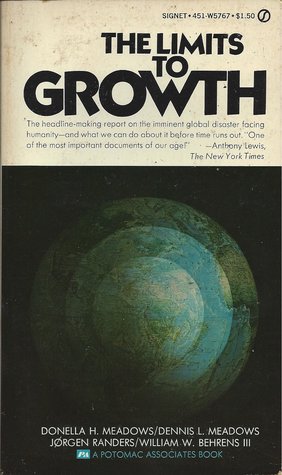
The message of this book still holds today: The earth’s interlocking resources – the global system of nature in which we all live – probably cannot support present rates of economic and population growth much beyond the year 2100, if that long, even with advanced technology. In the summer of 1970, an international team of researchers at the Massachusetts Institute of Technology began a study of the implications of continued worldwide growth. They examined the five basic factors that determine and, in their interactions, ultimately limit growth on this planet-population increase, agricultural production, nonrenewable resource depletion, industrial output, and pollution generation. The MIT team fed data on these five factors into a global computer model and then tested the behavior of the model under several sets of assumptions to determine alternative patterns for mankind’s future. The Limits to Growth is the nontechnical report of their findings. The book contains a message of hope, as well: Humans can create a society in which we can live indefinitely on earth if we impose limits on ourselves and our production of material goods to achieve a state of global equilibrium with population and production in carefully selected balance.
You can download a PDF version of The Limits To Growth from the main author’s website here.
“There are “50 simple things you can do to save the planet.” Buy an energy-efficient car, for one. Recycle your bottles and cans, vote knowledgeably in elections—if you are among those people in the world blessed with cars, bottles, cans, or elections. There are also not-so-simple things to do: Work out your own frugally elegant lifestyle, have at most two children, argue for higher prices on fossil energy (to encourage energy efficiency and stimulate development of renewable energy), work with love and partnership to help one family lift itself out of poverty, find your own “right livelihood,” care well for one piece of land, do whatever you can to oppose systems that oppress people or abuse the earth, run for election yourself.”
“People don’t need enormous cars; they need admiration and respect. They don’t need a constant stream of new clothes; they need to feel that others consider them to be attractive, and they need excitement and variety and beauty. People don’t need electronic entertainment; they need something interesting to occupy their minds and emotions. And so forth. Trying to fill real but nonmaterial needs-for identity, community, self-esteem, challenge, love, joy-with material things is to set up an unquenchable appetite for false solutions to never-satisfied longings. A society that allows itself to admit and articulate its nonmaterial human needs, and to find nonmaterial ways to satisfy them, world require much lower material and energy throughputs and would provide much higher levels of human fulfillment.”
Tropic of Chaos: Climate Change and the New Geography of Violence
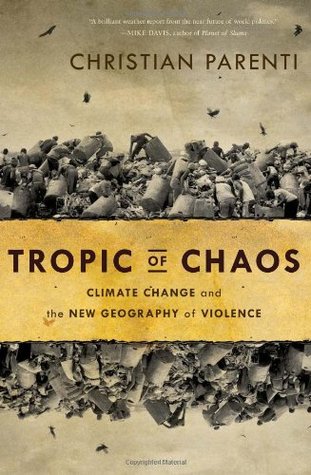
“In a world that sees two meter sea level rise, with continued flooding ahead, it will take extraordinary effort for the United States, or indeed any country, to look beyond its own salvation. All of the ways in which human beings have dealt with natural disasters in the past . . . could come together in one conflagration: rage at government’s inability to deal with the abrupt and unpredictable crises; religious fervor, perhaps even a dramatic rise in millennial end-of-days cults; hostility and violence toward migrants and minority groups, at a time of demographic change and increased global migration; and intra- and interstate conflict over resources, particularly food and fresh water.”
Greenhouse Gangsters vs Climate Justice

Read here
“The severity and planetwide nature of climate change represents a sort of an endgame for the global oil corporations. It sets up a showdown between the Greenhouse Gangsters whose activities are at the heart of the global warming crisis, and Climate Justice. The gathering forces of Climate Justice can be broadly defined as the interests of the vast majority of the world’s people and that of the ecological stability of the Earth. . .Climate Justice integrally links human rights and ecological sustainability, recognizing that the communities fighting to live free of the environmental and social problems created by big oil are also on the front lines in the battle against climate change.”
A concise briefing (it comes to 32 pages) on “Greenhouse gangsters”: the oil industry and other corporations which are threatening planetary health through harmful actions and ineffective responses, and the goals and proposed solutions of the Climate Justice movement to halt those actions and respond effectively to the climate crisis.
Contours of Climate Justice: Ideas for Shaping New Climate and Energy Politics
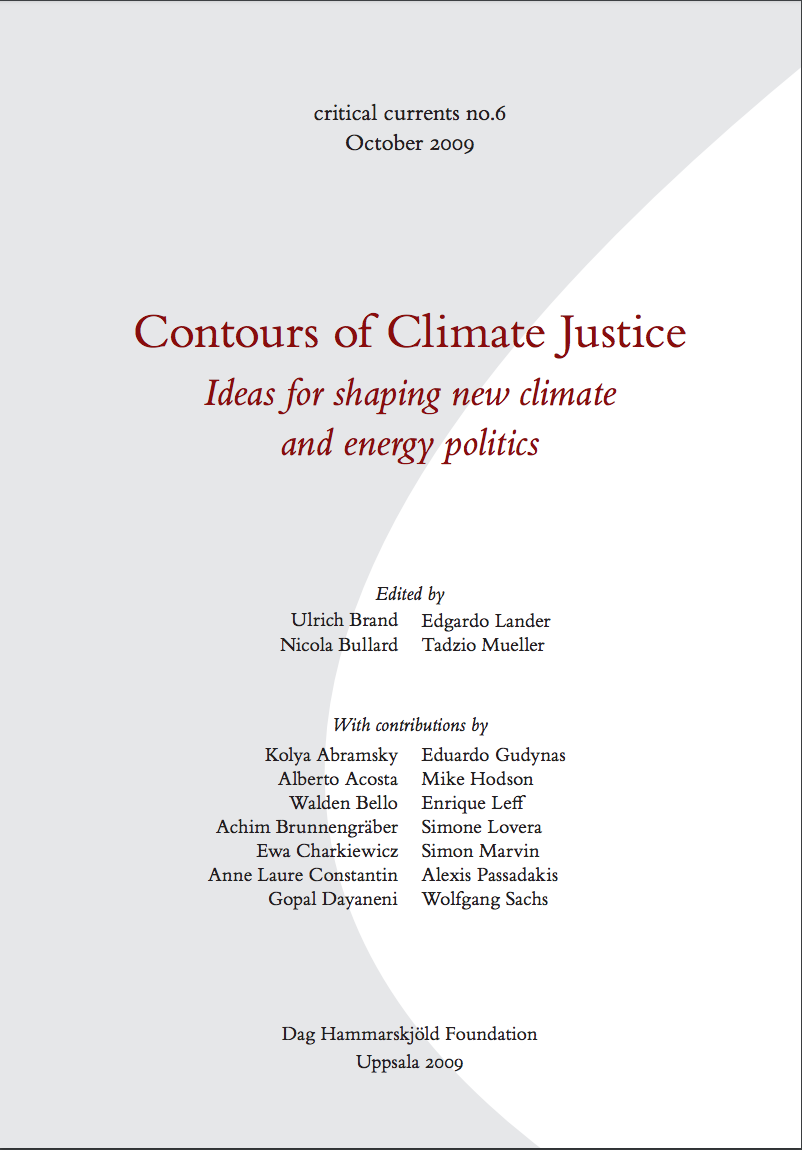
Read here
“There is something uncanny about the politics of climate change. An issue at the same time old and new; omnipresent, yet easily forgotten; threatening the destruction of billions of lives, yet somehow relegated to a relatively obscure corner of the global political system, the United Nations Framework Convention on Climate Change (UNFCCC), a treaty organisation far less powerful than, say, the World Trade Organization (WTO).”
A collection of essays from a variety of authors working internationally that investigate and illuminate the climate crisis in three parts: first, the policies, actions, and mindsets that led to the crisis; second, the “wrong turns, dead-ends and cross-roads” offered by potential solutions and policies; and third, the landscape of the current climate justice movement as it fights towards a sustainable future.
Politics of Climate Justice: Paralysis Above, Movement Below
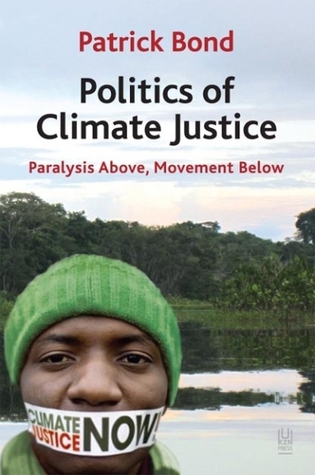
Read Here
“There is no way around it: to solve the worsening climate crisis requires we must accept both that the vast majority of fossil fuels must now be left underground, and that through democratic planning, we must collectively reboot our energy, transport, agricultural, production, consumption and disposal systems so that by 2050 we experience good living – the Bolivian ‘buen vivir’ including ‘Rights of Nature’ – with less than a quarter of our current levels of greenhouse gas emissions.”
With Speed and Violence: Why Scientists Fear Tipping Points in Climate Change
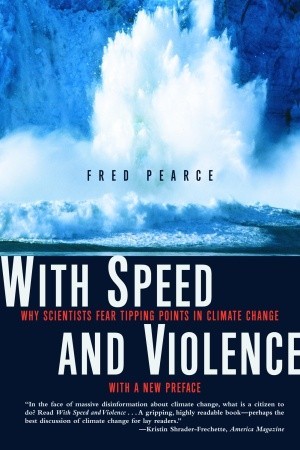
“Nature is fragile, environmentalists often tell us. But the lesson of this book is that it is not so. The truth is far more worrying. Nature is strong and packs a serious counterpunch . . . Global warming will very probably unleash unstoppable planetary forces. And they will not be gradual. The history of our planet’s climate shows that it does not do gradual change. Under pressure, whether from sunspots or orbital wobbles or the depredations of humans, it lurches—virtually overnight.”
The End of Nature

“The chief lesson is that the world displays a lovely order, an order comforting in its intricacy. And the most appealing part of this harmony, perhaps, is its permanence – the sense that we are part of something with roots stretching back nearly forever, and branches reaching forward just as far. Purely human life provides only a partial fulfillment of this desire for a kind of immortality.”
Reissued in 2006 with a new introduction by the author.
Eaarth: Making Life on a Tough New Planet
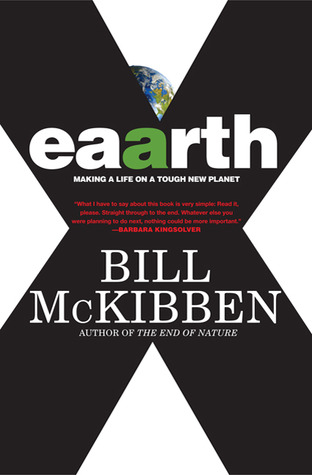
“Imagine we live on a planet. Not our cozy, taken-for-granted earth, but a planet, a real one, with dark poles and belching volcanoes and a heaving, corrosive sea, raked by winds, strafed by storms, scorched by heat. An inhospitable place. A different place. A different planet. It needs a new name: eaarth.”
McKibben paints a picture of what life will look like on an earth that’s undergoing the worst of climate change effects, a planet so altered from what we know now it might as well be a different planet: “Eaarth.” How will we repair our civilizations and protect ourselves from Eaarth—let alone drum up the money for such repairs and protections—when our economic system and its growth depend on the exhausted and degraded resources of a bygone Earth? McKibben argues for organizing in scaled-down decentralized communities (aka “Think Local”) that will be able to weather the storms we’ve made Eaarth throws at us. Eaarth’s solutions are focused more on how to cope with and mitigate the apocalypse than on averting it.
This Changes Everything: Capitalism vs. The Climate
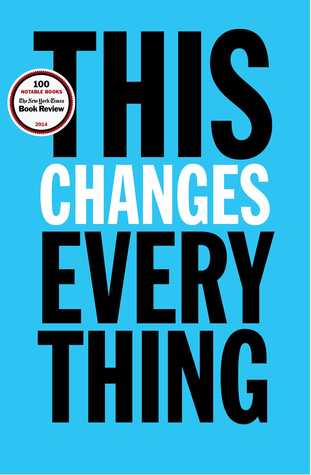
“What the climate needs to avoid collapse is a contraction in humanity’s use of resources; what our economic model demands to avoid collapse is unfettered expansion. Only one of these sets of rules can be changed, and it’s not the laws of nature.”
“Slavery wasn’t a crisis for British and American elites until abolitionism turned it into one. Racial discrimination wasn’t a crisis until the civil rights movement turned it into one. Sex discrimination wasn’t a crisis until feminism turned it into one. Apartheid wasn’t a crisis until the anti-apartheid movement turned it into one. In the very same way, if enough of us stop looking away and decide that climate change is a crisis worthy of Marshall Plan levels of response, then it will become one, and the political class will have to respond, both by making resources available and by bending the free market rules that have proven so pliable when elite interests are in peril.”
Why do we continue to “look away” from climate change, unable to acknowledge it as the crisis it truly is? Because the ideology and system of capitalism and its proponents—more specifically free-market fundamentalism aka neoliberalism—have systematically overpowered or silenced effective response. Its core policies of privatization, corporate deregulation, and lower corporate taxation are directly opposed to the policies needed to lower fossil fuel combustion. Addressing the climate crisis will call for tremendous economic and social change, not the false solutions offered by those same “disaster capitalists” (see her book The Shock Doctrine for more on this) who exploit social, economic, and now environmental upheavals to make themselves richer, or by geoengineers who assume the world is our resource to be used and manipulated without reciprocal stewardship or consequences. Importantly, though this crisis is urgent and disastrous, it’s also exciting and inspiring: this is a chance to create a society and economy that’s more equitable and compassionate, and the climate justice movement has already won several battles that are paving the way there. A book that will change the way you think about the reasons behind climate change and effective action going forward. (Also a documentary!)
Dead Pool: Lake Powell, Global Warming, and the Future of Water in the West
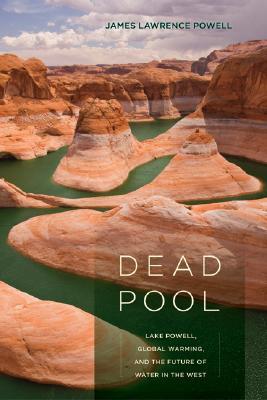
“…In only seventeen years, two major and opposite crises on the Colorado River threatened the Southwest. First came the flood, then came the drought. Both caught even the experts by surprise, revealing that in deciding to store twenty trillion gallons of Colorado River water behind concrete arch dams, then allowing a civilization to become dependent on that water, we did not know what we were doing. We gambled and got away with it—for now. But Nature is an implacable opponent, with unlimited time and energy. Keep rolling the dice with her, and eventually you will lose.”
Powell investigates the past, present, and future of American Southwest Anglo settlement through the lens of dams, using the Lake Powell reservoir straddling Arizona and Utah as a case study. He explains how the interests of the Bureau of Reclamation, developers, and landowners influenced the building of the dams got us to where we are today: huge desert agro-industrial farms sucking up a majority of the water and supercities like LA, Las Vegas, and Phoenix guzzling the rest, while reservoirs threaten to drop to “dead pool” levels: so low they can’t even spin the turbines used to generate hydroelectricity. A cautionary tale about water management and bribe-induced governmental decision-making.










